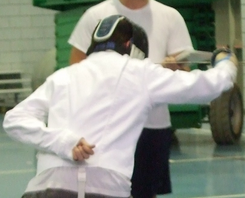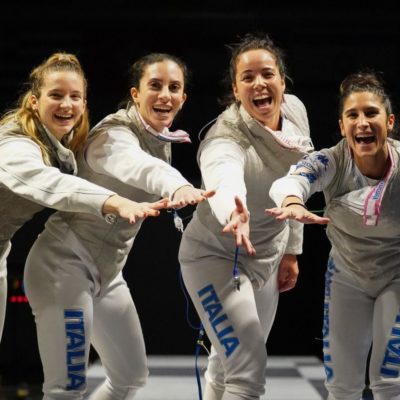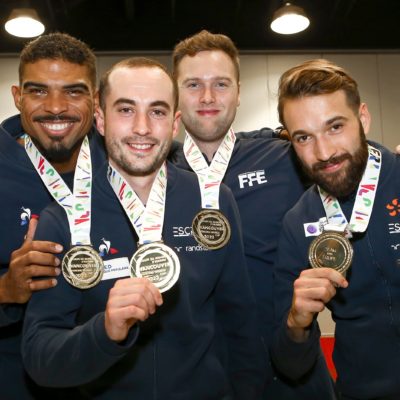
“I AM THE COMEBACK KID.”
Without a doubt, my favorite fencing event to attend as a spectator and coach is the Capitol Clash Super Youth Circuit (SYC). What originally began as a moderately sized event that took place at a local community college, the event has since exploded in the last few years and is now held at the massive Gaylord National Resort. The event has gotten so big in fact, that Wayne Jenness, one of the tournament administrators counted a total of 1,500 athletes checked in this year.
The Capitol Clash is an amazing tournament for many reasons. For one, it’s a joy to go into a room full of hundreds of enthusiastic fencers, see them jubilantly competing, and realize that these kids are the future of fencing. Chances are, one or two of the competitors in this event will be our future Olympians and ambassadors of the sport.
Secondly, there’s something about this event that causes many fencers to have their “awakening.” That moment where all of a sudden, what coach has taught the fencer begins to click, and the athlete is able to overcome nerves and go from a little kid holding a weapon to a real fencer. My mouth was agape, for instance as DC Fencers Club member Jacob Asher, an up and coming athlete in our club went from a 13-8 deficit to win 15-13. It’s moments like these that you remember fondly about the Capitol Clash, and they seem to happen frequently.
Overall, the event was a perfectly run, well-reffed tournament with a few hiccups in the form of a curmudgeonly parent. I provided my insights on “The Good, the Bad, and the Ugly” aspects of the 2014 Capitol Clash:
The Good
The Bout Committee- Have you ever tried to organize and (punctually) run a three day tournament with 1,500 fencers, 24 events, many new referees, and angst-ridden parents? Didn’t think so. But we should all tip our hats to Cindi Williams-Moore, Richard Weiss, David Sapery, Wayne Jenness, the Sanders family, and Mary Frye (sorry if I missed anyone) for running a tournament in a timely, efficient manner with very few hiccups. Fencers, get in a habit of thanking the bout committee. It’s not an easy job no matter the size of the tournament.
The Enthusiasm and Sportsmanship of the Fencers- In the Y12 Women’s Epee event, a young lady lost her bout 15-14. Particularly with younger fencers, it’s easy to feel dejected after a tough loss and become a dynamite of emotions, but the girl had a huge smile stretch across her face after her loss. As she began to pack up her bag to go, she turned to her mother and said “You know, I love being a fencer.” Child, I love that you love being a fencer. That’s exactly the kind of enthusiasm and attitude that parents and coaches alike should be fostering out of their kids.
There were other instances of sportsmanship on a smaller scale. Two teammates were about to fence in a D.E., and one approached the other before the bout, gave the other a hug and said “good luck, let’s have fun.” If there was incidental corps-a-corps that put another fencer on his/her buttocks throughout the day, the instigator was quick to offer a helping hand to get the other on his/her feet.
And what good would a youth event be without moments of levity? At one point, Fencer A lunged at Fencer B and accidentally hit him in the no-no zone. Fencer B fell to the ground and writhed in pain, as we all do when hit in the no-no zone. “Mom! I think I hurt him. Can we give him my spare cup?” asked Fencer A with the utmost sincerity. “No son. I don’t think he wants that” replied the mom with a smile on her face. Child, why do you have a spare cup anyhow?
Senator Elizabeth Warren. Regardless of your political leanings, it’s great when you have a Senator present at an event like the Capitol Clash! Senator Warren’s granddaughter was competing in the event. Despite having met her before, at one point, I turned to a teammate, and said “Gee, she sure looks like Elizabeth Warren doesn’t she?” “Yup. Can’t be her. Not at a fencing tournament,” he replied. Sure enough it was her.
Morehouse. Olympic Silver Medalist Tim Morehouse was present, signing autographs, selling his book, and promoting his new Morehouse USA apparel line. Morehouse took a picture with every single kid who came his way—kindness that goes a long way with the legions of kids who lined up to get their pictures taken with him. Tim and I chatted about some of his ambitious goals in the sport of fencing, which included improving technology, promoting his fencing in the schools program, and obtaining sponsorships from high profile companies. Post fencing retirement, Morehouse is staying busy. We’re going to benefit greatly from the ideas he’s putting into action.
The Bad
Where’s the Footwork? For the most part, I observed a lack of sound footwork in many fencers at the event. The common (and obvious) trend was that the fencers who walked away with medals typically had the best footwork compared to their peers. In the Y12 Women’s Epee event for instance, I was thoroughly impressed by the solid footwork of a girl named Vermeuele from Olympia Fencing Club. She was light on her feet, had an excellent sense of timing and tempo for a twelve year old, and I told one of my students to watch her to understand the importance of footwork. To no surprise, Vermeuele ended up with a bronze medal.
When children have the attention spans of a pygmy shrew on amphetamines, it’s difficult to say “I know it’s fun to play with the weapon, but let’s focus on the footwork a little more.” Nellya, Manhattan, Luchetti, Atlantic, NYFA, and Olympia were just some of the clubs getting fencers into the top eight with consistency. Their X-factor? Their footwork. The more footwork is taught in the youth ranks, the less time will be spent correcting it later on.
Whether it was an en garde position standing straight up sans bent knees, feet flat on the ground, or the ceasing of movement entirely, footwork for the most part was forgotten at the Capitol Clash. Those who floated like a butterfly and stung like bees walked away with medals. Those who played the beached whale game did not.
The Tense Back Arm. Bad trend #2 I saw was the tense back arm, which led to an overall tight upper body in many of the fencers present. In modern fencing, it’s important to position the back arm in a way that creates relaxation in the upper body. There’s a tendency with younger fencers to roll their back arm shoulder backwards and tuck their arm away. Such tension in the shoulders and back creates rigidity in a fencer akin to that of a drawn bow. Below is an example of the form I’m talking about. Keep that upper body loose, kids!
The Ugly
The parent black card, and a reaffirmation of my belief that we’re not doing enough to protect our referees. Y12 Men’s Sabre event. 14-14, Fencer A jumps the gun before ref calls fence. Single light. Touch annulled. Ready, fence. Fencer B gets a decisive single light touch off the line.
“YOU SUCK!” Parent of Fencer A yells at referee.
Referee pulls out yellow card.
“YOU SUCK! YOU SUCK! YOU SUCK! YOU WANT TO TAKE THIS OUTSIDE? LET’S GO!”
Referee pulls out the most well deserved black card of the century.
Yes, you read that correctly. A whifferninny parent got black carded for threatening physical violence on a referee. Despicable. Shameful. An unprecedented incident and a temperamental outburst unlike anything I’ve encountered in almost twenty years in the sport.
But the worst part of this incident? The parent was back in the venue the next day. A black card of such uncouth gravitas should not allow such a man to waltz back into a fencing event. It should require an indefinite suspension of the parent with the condition that they are not allowed to watch their child compete without a dose of therapy and anger management courses. We owe more to our referees than giving instigators of violence a slap on the wrist with zero consequences other than the temporary shame of embarrassing your son.
This echoes the incident from the Miami Summer Nationals in which a coach nearly punched a referee and was back in the venue the next day post black card, as if nothing happened. Physical violence and intimidation has no place in our sport. It’s time for the USFA to institute a zero tolerance policy for anyone who initiates or even threatens to initiate violence towards our officials. Hillary Clinton once wrote a book called “It Takes a Village to Raise a Child.” Well, I say “It takes a fencing community to teach good sportsmanship and protect our kids and referees against foondanglin’ whifferninnies who are more concerned with winning than developing fencers as upstanding human beings.”
Overall. The Capitol Clash was a great success in bringing over 1,500 kids together for a NAC sized experience that featured the likes of Tim Morehouse and Elizabeth Warren in attendance. The tournament was run seamlessly, the kids had fun, and we got a glimpse of our future Olympians and ambassadors of the sport. Congratulations to all the fencers and the hard work you put in in preparation for the event, and may you continue to find love and joy in the sport of fencing!







